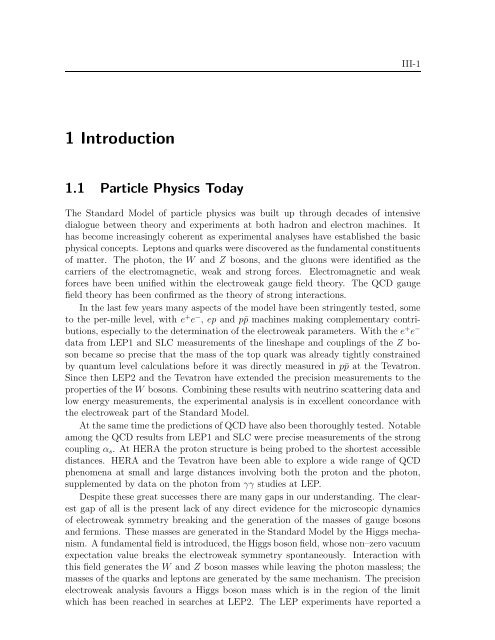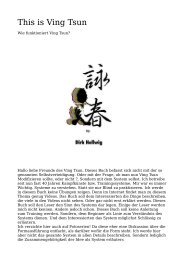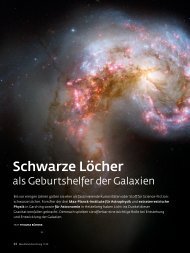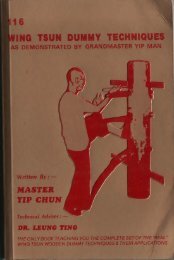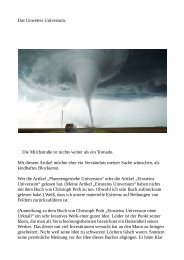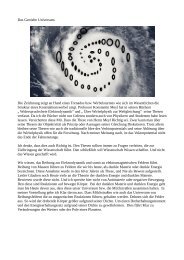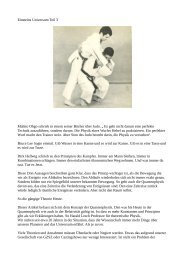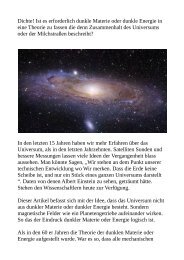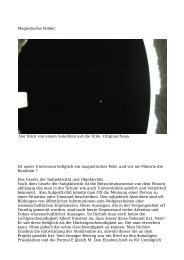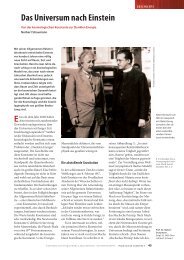Artikel über N.Tesla
Alte Datei über Tesla und seine Arbeit.
Alte Datei über Tesla und seine Arbeit.
Create successful ePaper yourself
Turn your PDF publications into a flip-book with our unique Google optimized e-Paper software.
III-1<br />
1 Introduction<br />
1.1 Particle Physics Today<br />
The Standard Model of particle physics was built up through decades of intensive<br />
dialogue between theory and experiments at both hadron and electron machines. It<br />
has become increasingly coherent as experimental analyses have established the basic<br />
physical concepts. Leptons and quarks were discovered as the fundamental constituents<br />
of matter. The photon, the W and Z bosons, and the gluons were identified as the<br />
carriers of the electromagnetic, weak and strong forces. Electromagnetic and weak<br />
forces have been unified within the electroweak gauge field theory. The QCD gauge<br />
field theory has been confirmed as the theory of strong interactions.<br />
In the last few years many aspects of the model have been stringently tested, some<br />
to the per-mille level, with e + e − , ep and p¯p machines making complementary contributions,<br />
especially to the determination of the electroweak parameters. With the e + e −<br />
data from LEP1 and SLC measurements of the lineshape and couplings of the Z boson<br />
became so precise that the mass of the top quark was already tightly constrained<br />
by quantum level calculations before it was directly measured in p¯p at the Tevatron.<br />
Since then LEP2 and the Tevatron have extended the precision measurements to the<br />
properties of the W bosons. Combining these results with neutrino scattering data and<br />
low energy measurements, the experimental analysis is in excellent concordance with<br />
the electroweak part of the Standard Model.<br />
At the same time the predictions of QCD have also been thoroughly tested. Notable<br />
among the QCD results from LEP1 and SLC were precise measurements of the strong<br />
coupling α s . At HERA the proton structure is being probed to the shortest accessible<br />
distances. HERA and the Tevatron have been able to explore a wide range of QCD<br />
phenomena at small and large distances involving both the proton and the photon,<br />
supplemented by data on the photon from γγ studies at LEP.<br />
Despite these great successes there are many gaps in our understanding. The clearest<br />
gap of all is the present lack of any direct evidence for the microscopic dynamics<br />
of electroweak symmetry breaking and the generation of the masses of gauge bosons<br />
and fermions. These masses are generated in the Standard Model by the Higgs mechanism.<br />
A fundamental field is introduced, the Higgs boson field, whose non–zero vacuum<br />
expectation value breaks the electroweak symmetry spontaneously. Interaction with<br />
this field generates the W and Z boson masses while leaving the photon massless; the<br />
masses of the quarks and leptons are generated by the same mechanism. The precision<br />
electroweak analysis favours a Higgs boson mass which is in the region of the limit<br />
which has been reached in searches at LEP2. The LEP experiments have reported a


